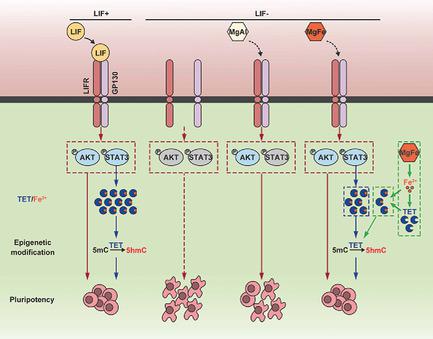Our official English website, www.x-mol.net, welcomes your
feedback! (Note: you will need to create a separate account there.)
MgFe‐LDH Nanoparticles: A Promising Leukemia Inhibitory Factor Replacement for Self‐Renewal and Pluripotency Maintenance in Cultured Mouse Embryonic Stem Cells
Advanced Science ( IF 14.3 ) Pub Date : 2021-02-25 , DOI: 10.1002/advs.202003535 Xiaolie He 1 , Yanjing Zhu 1 , Li Yang 1 , Zhaojie Wang 1 , Zekun Wang 1 , Jianhao Feng 1 , Xuejun Wen 1, 2 , Liming Cheng 1 , Rongrong Zhu 1
Advanced Science ( IF 14.3 ) Pub Date : 2021-02-25 , DOI: 10.1002/advs.202003535 Xiaolie He 1 , Yanjing Zhu 1 , Li Yang 1 , Zhaojie Wang 1 , Zekun Wang 1 , Jianhao Feng 1 , Xuejun Wen 1, 2 , Liming Cheng 1 , Rongrong Zhu 1
Affiliation

|
Leukemia inhibitory factor (LIF), an indispensable bioactive protein that sustains self‐renewal and pluripotency in stem cells, is vital for mouse embryonic stem cell (mESC) culture. Extensive research is conducted on reliable alternatives for LIF as its clinical application in stable culture and large‐scale expansion of ESCs is limited by its instability and high cost. However, few studies have sought to replace LIF with nanoparticles to provide a xeno‐free culture condition. MgAl‐LDH (layered double hydroxide) nanoparticles can partially replace LIF in maintaining pluripotency of mESCs; however, the requirement and tolerance for aluminum ions in mice are far lesser than those of iron ions. Hence, MgFe‐LDH nanoparticles are selected for this study. MgFe‐LDH is superior to MgAl‐LDH in maintaining self‐renewal and pluripotency of mESCs, in the absence of LIF and mouse embryonic fibroblast. Furthermore, combined transcriptomic and proteomic analysis confirms that MgFe‐LDH can activate the LIF receptor (LIFR)/phosphatidylinositol 3‐kinase (PI3K)/protein kinase B(AKT), LIFR/JAK/janus kinase (JAK)/signal transducer and activator of transcription 3(STAT3), and phospho‐signal transducer and activator of transcription 3(p‐STAT3)/ten‐eleven translocation (TET) signaling pathways, while the extra Fe2+ provided by MgFe‐LDH would also enhance TET1/2 abundance thus affecting the TET1/2 regulated pluripotency related marker expression and TET1/2 meditated DNA demethylation. These results suggest that MgFe‐LDH nanoparticles can thus be used as an affordable and efficient replacement for LIF in mESC cultivation.
中文翻译:

MgFe-LDH 纳米颗粒:一种有前途的白血病抑制因子替代品,用于培养小鼠胚胎干细胞的自我更新和多能性维持
白血病抑制因子(LIF)是一种维持干细胞自我更新和多能性的不可或缺的生物活性蛋白,对于小鼠胚胎干细胞(mESC)培养至关重要。由于 LIF 的不稳定性和高成本限制了其在稳定培养和大规模扩增 ESC 中的临床应用,因此人们对 LIF 的可靠替代品进行了广泛的研究。然而,很少有研究试图用纳米粒子取代 LIF 以提供无异源培养条件。MgAl-LDH(层状双氢氧化物)纳米颗粒可以部分替代LIF来维持mESC的多能性;然而,小鼠对铝离子的需要量和耐受性却远低于铁离子。因此,本研究选择 MgFe-LDH 纳米颗粒。在缺乏 LIF 和小鼠胚胎成纤维细胞的情况下,MgFe-LDH 在维持 mESC 的自我更新和多能性方面优于 MgAl-LDH。此外,结合转录组学和蛋白质组学分析证实,MgFe-LDH 可以激活 LIF 受体 (LIFR)/磷脂酰肌醇 3-激酶 (PI3K)/蛋白激酶 B(AKT)、LIFR/JAK/janus 激酶 (JAK)/信号转导器和激活剂转录 3(STAT3) 和磷酸信号转导子和转录激活子 3(p-STAT3)/10-11 易位 (TET) 信号通路,而 MgFe-LDH 提供的额外 Fe 2+ 也会增强 TET1 / 2丰度从而影响 TET1/2 调节多能性相关标记的表达和 TET1/2 介导的 DNA 去甲基化。这些结果表明,MgFe-LDH 纳米颗粒因此可以在 mESC 培养中用作 LIF 的经济且有效的替代品。
更新日期:2021-05-05
中文翻译:

MgFe-LDH 纳米颗粒:一种有前途的白血病抑制因子替代品,用于培养小鼠胚胎干细胞的自我更新和多能性维持
白血病抑制因子(LIF)是一种维持干细胞自我更新和多能性的不可或缺的生物活性蛋白,对于小鼠胚胎干细胞(mESC)培养至关重要。由于 LIF 的不稳定性和高成本限制了其在稳定培养和大规模扩增 ESC 中的临床应用,因此人们对 LIF 的可靠替代品进行了广泛的研究。然而,很少有研究试图用纳米粒子取代 LIF 以提供无异源培养条件。MgAl-LDH(层状双氢氧化物)纳米颗粒可以部分替代LIF来维持mESC的多能性;然而,小鼠对铝离子的需要量和耐受性却远低于铁离子。因此,本研究选择 MgFe-LDH 纳米颗粒。在缺乏 LIF 和小鼠胚胎成纤维细胞的情况下,MgFe-LDH 在维持 mESC 的自我更新和多能性方面优于 MgAl-LDH。此外,结合转录组学和蛋白质组学分析证实,MgFe-LDH 可以激活 LIF 受体 (LIFR)/磷脂酰肌醇 3-激酶 (PI3K)/蛋白激酶 B(AKT)、LIFR/JAK/janus 激酶 (JAK)/信号转导器和激活剂转录 3(STAT3) 和磷酸信号转导子和转录激活子 3(p-STAT3)/10-11 易位 (TET) 信号通路,而 MgFe-LDH 提供的额外 Fe 2+ 也会增强 TET1 / 2丰度从而影响 TET1/2 调节多能性相关标记的表达和 TET1/2 介导的 DNA 去甲基化。这些结果表明,MgFe-LDH 纳米颗粒因此可以在 mESC 培养中用作 LIF 的经济且有效的替代品。










































 京公网安备 11010802027423号
京公网安备 11010802027423号